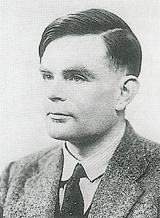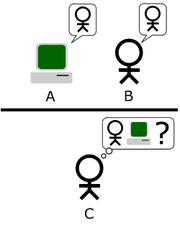Turing Test
So today we will talk about the most famous test for evaluating a talking bot - this is the Turing test.

The Turing test is an empirical test, the idea of which was proposed by Alan Turing in the article “Computing Machinery and Intelligence”, published in 1950 in the philosophical journal Mind. Turing set out to determine whether the machine can think.
The standard sound of the law: “If a computer can work in such a way that a person is not able to determine with whom he communicates - with another person or with a machine - it is considered that he passed the Turing test”
Intelligent, human-like machines have been one of the main themes of science fiction for many decades. Since the inception of modern computing technology, people's minds have been wondering whether it is possible to build a machine that could replace a person in some way. An attempt to create a solid empirical basis for solving this problem was the test developed by Alan Turing.
The first version of the test, published in 1950, was somewhat confusing. The current version of the Turing test is the following task. An expert group communicates with an unknown creature. They do not see their interlocutor and can communicate with him only through some kind of isolating system - for example, a keyboard. They are allowed to ask the interlocutor any questions, to have a conversation on any topic. If at the end of the experiment they cannot say whether they communicated with a person or with a machine, and if in fact they were talking with a machine, we can assume that this machine passed the Turing test.
There are at least three basic versions of the Turing test, two of which were proposed in the article “Computers and Mind”, and the third, in Saul Traiger’s terminology, is a standard interpretation.
Along with the fact that there is a certain discussion, whether the modern interpretation corresponds to what Turing described, or whether it is the result of a misinterpretation of his works, all three versions are not considered equivalent, their strengths and weaknesses differ.
Simulation game
Turing, as we already know, described a simple party game that includes at least three players. Player A is a man, Player B is a woman and Player C, who plays as a conversation leader, of any gender. According to the rules of the game, C sees neither A nor B and can communicate with them only by means of written messages. By asking questions to players A and B, C is trying to determine which of them is a man and who is a woman. The task of player A is to confuse player C so that he makes a wrong conclusion. At the same time, the task of player B is to help player C to make a correct judgment.
')
In the version that SG Sterret calls the “Original Imitation Game Test” (Initial Imitation Game Test), Turing suggests that the role of Player A be played by a computer. Thus, the task of a computer is to pretend to be a woman in order to confuse player C. The success of such a task is estimated based on a comparison of the outcomes of the game, when player A is a computer, and outcomes when player A is a man. If, according to Turing, “the player leading the conversation after playing the game [with the computer] makes the wrong decision as often as after the game with the participation of the man and the woman”, then we can say that the computer is intelligent.
The second option is proposed by Turing in the same article. As in the "Initial Test", the role of Player A is performed by a computer. The difference lies in the fact that the role of player B can play both a man and a woman.
“Let's look at a specific computer. Is it true that modifying this computer to have enough space to store data, increasing its speed and setting it a suitable program, you can construct such a computer so that it satisfactorily performs the role of player A in a simulation game, while the role of player B does a man perform? ”, Turing, 1950, p. 442.
In this variant, both players A and B are trying to persuade the leader to the wrong decision.
The main idea of this version is that the goal of the Turing test is to answer not to the question whether the machine can fool the leader, but to the question whether the machine can imitate a person or not. Although there are disputes over whether this option was implied by Turing or not, Sterret believes that this option was implied by Turing and, thus, combines the second option with the third. At the same time, a group of opponents, including Trader, does not think so. But it still led to what can be called the "standard interpretation." In this variant, player A is a computer, player B is a person of any gender. The task of the presenter is now not to determine which of them is a man and a woman, and who among them is a computer, and who is a man.
Turing in 2012
To organize events to celebrate the centenary of Turing’s birth in 2012, a special committee was created to bring Turing’s thought about a reasonable machine, reflected in Hollywood films such as Blade Runner, to the general public, including children. Committee members: Kevin Warwick, Chairman, Hume Sha, Coordinator, Ian Bland, Chris Chapman, Marc Allen, Rory Dunlop, Löbner Robbie Prize Winners Garne and Fred Roberts. The committee works with the support of the organization Women in Technology (Women in Technology) and Daden Ltd.

The Turing test is an empirical test, the idea of which was proposed by Alan Turing in the article “Computing Machinery and Intelligence”, published in 1950 in the philosophical journal Mind. Turing set out to determine whether the machine can think.
The standard sound of the law: “If a computer can work in such a way that a person is not able to determine with whom he communicates - with another person or with a machine - it is considered that he passed the Turing test”
Intelligent, human-like machines have been one of the main themes of science fiction for many decades. Since the inception of modern computing technology, people's minds have been wondering whether it is possible to build a machine that could replace a person in some way. An attempt to create a solid empirical basis for solving this problem was the test developed by Alan Turing.
The first version of the test, published in 1950, was somewhat confusing. The current version of the Turing test is the following task. An expert group communicates with an unknown creature. They do not see their interlocutor and can communicate with him only through some kind of isolating system - for example, a keyboard. They are allowed to ask the interlocutor any questions, to have a conversation on any topic. If at the end of the experiment they cannot say whether they communicated with a person or with a machine, and if in fact they were talking with a machine, we can assume that this machine passed the Turing test.

There are at least three basic versions of the Turing test, two of which were proposed in the article “Computers and Mind”, and the third, in Saul Traiger’s terminology, is a standard interpretation.
Along with the fact that there is a certain discussion, whether the modern interpretation corresponds to what Turing described, or whether it is the result of a misinterpretation of his works, all three versions are not considered equivalent, their strengths and weaknesses differ.
Simulation game
Turing, as we already know, described a simple party game that includes at least three players. Player A is a man, Player B is a woman and Player C, who plays as a conversation leader, of any gender. According to the rules of the game, C sees neither A nor B and can communicate with them only by means of written messages. By asking questions to players A and B, C is trying to determine which of them is a man and who is a woman. The task of player A is to confuse player C so that he makes a wrong conclusion. At the same time, the task of player B is to help player C to make a correct judgment.
')
In the version that SG Sterret calls the “Original Imitation Game Test” (Initial Imitation Game Test), Turing suggests that the role of Player A be played by a computer. Thus, the task of a computer is to pretend to be a woman in order to confuse player C. The success of such a task is estimated based on a comparison of the outcomes of the game, when player A is a computer, and outcomes when player A is a man. If, according to Turing, “the player leading the conversation after playing the game [with the computer] makes the wrong decision as often as after the game with the participation of the man and the woman”, then we can say that the computer is intelligent.
The second option is proposed by Turing in the same article. As in the "Initial Test", the role of Player A is performed by a computer. The difference lies in the fact that the role of player B can play both a man and a woman.
“Let's look at a specific computer. Is it true that modifying this computer to have enough space to store data, increasing its speed and setting it a suitable program, you can construct such a computer so that it satisfactorily performs the role of player A in a simulation game, while the role of player B does a man perform? ”, Turing, 1950, p. 442.
In this variant, both players A and B are trying to persuade the leader to the wrong decision.
The main idea of this version is that the goal of the Turing test is to answer not to the question whether the machine can fool the leader, but to the question whether the machine can imitate a person or not. Although there are disputes over whether this option was implied by Turing or not, Sterret believes that this option was implied by Turing and, thus, combines the second option with the third. At the same time, a group of opponents, including Trader, does not think so. But it still led to what can be called the "standard interpretation." In this variant, player A is a computer, player B is a person of any gender. The task of the presenter is now not to determine which of them is a man and a woman, and who among them is a computer, and who is a man.
Turing in 2012
To organize events to celebrate the centenary of Turing’s birth in 2012, a special committee was created to bring Turing’s thought about a reasonable machine, reflected in Hollywood films such as Blade Runner, to the general public, including children. Committee members: Kevin Warwick, Chairman, Hume Sha, Coordinator, Ian Bland, Chris Chapman, Marc Allen, Rory Dunlop, Löbner Robbie Prize Winners Garne and Fred Roberts. The committee works with the support of the organization Women in Technology (Women in Technology) and Daden Ltd.
Source: https://habr.com/ru/post/69758/
All Articles